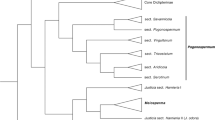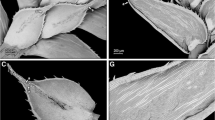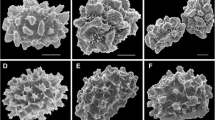Abstract
A taxonomical revision of the genusFestuca sect.Eskia in the Iberian Peninsula is presented. Seven species and two hybrid taxa are recognized in this section in the area studied. Karyological data show that six of the studied taxa (F. pseudeskia, F. scariosa, F. elegans subsp.elegans, F. burnatii, F. eskia, andF. ×picoeuropeana) are diploids, two of them are both diploid and tetraploid (F. gautieri andF. quadriflora), one is tetraploid (F. elegans subsp.merinoi) and the ploidy level of one taxon (F. ×souliei) is unknown. A new combinationF. elegans subsp.merinoi (Pau)Fuente etOrtúñez is published. A key based on data collected in this study allows for the identification of all taxa in this section. The complete description of each taxon is presented, as well as the ecology and chorology, including distribution maps. The illustrations summarize plant habits and the morphological and anatomical pattern observed on spikelets, ligules and leaf cross sections. Epidermal features were studied using scanning electron microscopy.
Similar content being viewed by others
References
Auquier P. (1974):Biosystématique, taxonomie et nomenclature du groupe de Festuca ovinaL. s.l. (Poaceae)en Belgique et dans quelques régions voisines. D. Sc. thesis, University of Liège, Liège.
Borrill M. (1972): Studies inFestuca III. The contribution ofF. scariosa to the evolution of polyploids in sectionsBovinae andScariosae.New Phytol. 71: 523–532.
Borrill M., Kirby M. &Morgan W.G. (1977): Studies inFestuca 11. Interrelationships of some putative diploid ancestors of the polyploid broad-leaved fescues.New Phytol. 78: 661–674.
Borrill M., Tyler B. &Lloyd-Jones M. (1971): Studies inFestuca I. A chromosome atlas ofbovinae andscariosae.Cytologia 36: 1–14.
Bulińska-Radomska Z. &Lester R.N. (1986): Phylogeny of chromosome races ofFestuca arundinacea andF. mairei (Poaceae) as indicated by seed protein electrophoresis.Pl. Syst. Evol. 152: 153–166.
Burdet H.M., Charpin A. &Jacquemoud F. (1981): Types nomenclaturales des taxa ibériques décrits par Boissier ou Router. I. Gymnospermes à Graminées.Candollea 36: 543–584.
Conert H. J. (1994):Festuca. In:Hegi G. (ed.),Illustrierte Flora von Mittel-Europa I (3. 7). Blackwell Wissenschafts-Verlag, Berlin, pp. 530–560.
Devesa J. A. &Luque T. (1988): Contribución al conocimiento cariológico de la subfam.Poideae (Poaceae) en el SW de España.Bol. Soc. Brot., Sér. 2, 61: 281–304.
Devesa J.A., Ruiz T., Tormo R., Muñoz A., Viera M.C., Carrasco J.P., Ortega A. &Pastor J. (1990): Contribución al conocimiento cariológico de lasPoaceae en Extremadura (España) II.Bol. Soc. Brot., Sér. 2, 63: 153–205.
Ellis R. P. (1976): A procedure for standardizing comparative leaf anatomy in thePoaceae. I. The leaf-blade as viewed in transversal section.Bothalia 12: 65–109.
Ellis R. P. (1979): A procedure for standardizing comparative leaf anatomy in thePoaceae. II. The epidermis as seen in surface view.Bothalia 12: 641–671.
Fernandes A. &Queirós M. (1969): Contribution à la connaisance cytotaxinomique des Spermatophyta du Portugal, I.Gramineae. Bol. Soc. Brot., Sér. 2, 43: 3–140.
Ferrero L.M. &Fuente V. (1996): Aportaciones al estudio cariológico de algunas especies del géneroFestuca L. endémicas del Mediterráneo Occidental.Bol. Soc. Brot., Sér. 2, 67: 303–308.
Fuente V. &Ortúñez E. (1988): Datos corológicos de algunos taxones ibéricos del géneroFestuca L.Lagascalia 15 (Extra): 465–473.
Fuente V., Palacio C., Ferrero L.M. &Ortúñez E. (1994):F. elegans Boiss. In:Fernández Casas J., Gamarra R. & Morales M.J. (eds.), Asientos para un Atlas corológico de la flora occidental, 22,Fontqueria 40: 171–180.
Fuente V. &Ortúñez E. (1998):Biosistemática de la sección Festucadel género FestucaL. (Poaceae)en la Península Ibérica. Universidad Autónoma de Madrid, Madrid.
Fuente V., Sánchez Mata D. &Moreno Saiz J. C. (1988): Tipificaciones en el berbario original de E. Hackel.Candollea 43: 513–520.
Gutiérrez Villarías M.I. (1992a): Lectotipificación deFestuca burnatii Saint-Yves (Poaceae).Bol. Cienc. Nat. IDEA 42: 19–20.
Gutiérrez Villarías M.I. (1992b): The correct name of the hybrid betweenFestuca gautieri andFestuca eskia (Poaceae).Taxon 41: 76–77.
Gutiérrez Villarías M.I. &Homet J. (1984): Estudio de un nuevo taxon del géneroFestuca L. secciónVariae Hack. de los Picos de Europa.Bol. Cienc. Nat. IDEA 34: 131–153.
Hackel E. (1881): Die verwandtschaftlichen Beziehungen und die geographische Verbreitung der europäischenFestuca-Arten.Bot. Centralbl. 4: 401–419.
Hackel E. (1882):Monographia Festucarum Europearum. Kassel, Berlin.
Holmgren P.K., Holmgren N.H. & Barnett L.C. (1990): Index herbariorum 1. The herbaria of the world. ed 8.Regnum Veg. 120.
Jahandiez E. & Maire R. (1931):Catalogue des plantes du Maroc (Spermatophytes et Pteridophytes) 1. Alger.
Kerguélen M. (1975): LesGramineae (Poaceae) de la flore française. Essai de mise au point taxonomique et nomenclaturale.Lejeunia, Nouv. Sér., 75: 1–343.
Kerguélen M. &Plonka F. (1989): LesFestuca de la Flore de France (Corse comprise).Bull. Soc. Bot. Centre-Ouest, Nouv. sér., Núm. spécial 10: 1–368.
Krajina V. (1933): Bemerkungen zur Verbreitung und Systematik der GattungFestuca in den rumänischen Karpathen.Veröff. Geobot. Inst. Rübel Zürich 10: 3–30
Küpfer P.M. (1968): Nouvelles prospections caryologiques dans la flore orophile des Pyrénées et de la Sierra Nevada.Bull. Soc. Neuchâteloise Sci. Nat. 91: 87–104.
Küpfer P. M. (1969): Recherches cytotaxonomiques sur la flore des montagnes de la péninsule ibérique.Bull. Soc. Neuchâteloise Sci. Nat. 92: 31–48.
Küpfer P.M. (1971): Liens génétique entre les flores alpine et pyrénénne.Ann. Litt. Univ. Besançon 21: 167–185.
Küpfer P.M. (1974): Recherches sur les liens de parenté entre la flore orophile des Alpes et celle des Pyrénées.Boissiera 23: 3–322.
Levitsky G.A. &Kuzmina N.E. (1927): Karyological investigations on the systematics and phylogenetics of the genusFestuca.Bull. Appl. Bot. Genet. Pl. Breed. 17: 3–36.
Litardière R. de (1950): Nombre chromosomique de diversesGraminées.Bol. Soc. Brot., Sér. 2, 24: 79–87.
Litardière R. de (1954): Contribution à l’étude duFestuca burnatii St.-Y.Collect. Bot. (Barcelona) 4: 179–181.
Maire R. (1955):Flore de l’Afrique du Nord. vol. III. Encyclopédie biologique XLVIII. Paul Lechevalier, Paris.
Markgraf-Dannenberg I. von (1979):Festuca-Probleme in ökologisch-soziologischen Zusammenhang. In: Nachheft zum Bericht über die Internationale Fachtagung “Bedeutung der Pflanzensoziologie für eine standortgemässe und umweltgerechte Land-und Almwirtschaft”, 12. u. 13. Sept. 1978, Gumpenstein, Bundesversuchsanstalt für alpenländische Landwirtschaft Gumpenstein, Irdning, pp. 337–386.
Markgraf-Dannenberg I. von (1980):Festuca L. In:Tutin T.G., Heywood V.H., Burgess N.A., Moore D.M., Valentine D.H., Walters S.M. &Webb D.A. (eds.),Flora europaea 5, Cambridge University Press, Cambridge, pp. 125–154.
Metcalfe C. R. (1960):Anatomy of the Monocotyledons 1. Gramineae. Clarendon Press, Oxford.
Morgan W.G., Thomas H. &Kirby M. (1979): A study of chromosome association in hybrids between diploid species ofFestuca.Chromosoma (Berlin) 75: 117–127.
Nava H.S. (1985): El grupoFestuca varia en Picos de Europa.Fontqueria 7: 21–24.
Nègre R. (1975): Observations morphologiques sur les gentianes du groupealpina-acaulis, surFestuca paniculata etF. eskia en Pyrénées.Candollea 30: 301–321.
Palmer P.G. &Tucker A.E. (1981): A scanning electron microscope survey of the epidermis of East African grasses. 1.Smithsonian Contr. Bot. 49: 1–84.
Portal R. (1999): Festucade France. Imprimerie Jeanne-D’Arc, Le Puy-en-Velay.
Rivas Goday S. &Rivas Martínez S. (1963):Estudio y clasificación de los pastizales españoles. Pub. Ministerio Agricultura, Madrid.
Rivas Martínez S., Asensi A., Molero Mesa J. &Valle F. (1991): Endemismos vasculares de Andalucía.Rivasgodaya 6: 5–76.
Romero Zarco C. (1984): Números cromosómicos para la flora española. Números 337–341.Lagascalia 12: 292–294.
Rougeot M.C. (1974): Contribution à l’étude taxonomique duFestuca varia Haenke ssp.eu-varia Hack. des Alpes françaises.Ann. Sci. Univ. Besançon, Bot., 15: 59–108.
Saint-Yves A. (1913): LesFestuca de la sectionEu-Festuca et leurs variations dans les Alpes Maritimes.Annuaire Conserv. Jard. Bot. Genève 17: 1–218.
Saint-Yves A. (1922): LesFestuca (subg.Eu-Festuca) de l’Afrique du Nord et des Iles Atlantiques.Candollea 1: 1–63
Seal A.G. (1983): DNA variation inFestuca.Heredity 50: 225–236.
Wilkinson M. J. &Stace C. (1991): A new taxonomic treatment of theFestuca ovina L. aggregate (Poaceae) in the British Isles.Bot. J. Linn. Soc. 106: 347–397.
Willkomm M. (1861): Fam. 19.Gramineae Juss. In:Willkomm M. & Lange J. (eds.),Prodromus florae hispanicae I, Stuttgart, pp. 33–118.
Author information
Authors and Affiliations
Corresponding author
Rights and permissions
About this article
Cite this article
de la Fuente, V., Ortúñez, E. Festuca sect.Eskia (Poaceae) in the Iberian Peninsula. Folia Geobot 36, 385–421 (2001). https://doi.org/10.1007/BF02899988
Received:
Revised:
Accepted:
Issue Date:
DOI: https://doi.org/10.1007/BF02899988




